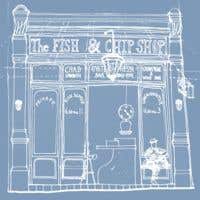This article was also published in the Financial Times.
Fish and chips, that quintessentially British combination, is a dish that works on many levels.
There is the crispness of the batter, the freshness and flakiness of the fish, the irresistible nature of the chips, particularly if they are straight out of the frying pan, and, finally, the extras. Salt and vinegar, and yes please to plenty of both for me, though I have no time for the mushy peas that are a traditional accompaniment in British fish and chip shops.
Fish and chips also works on another, more subliminal, level. Because it is a combination that many of us are introduced to as children, it arrives in subsequent servings topped with lashings of nostalgia. Just the mention of this delectable duo brings back the memory of walking home after Cubs on a Tuesday night in the 1950s and years later of an evening standing in a friend's garden in Auckland watching excited children, including my own, demolish platefuls of 'fush'n'chups', as they are called in New Zealand.
Nostalgia takes many forms in The Fish & Chip Shop that has recently opened on Upper Street, Islington, north London, a street that appears to be home to more restaurants than any other in our capital.
There is the small, neatly folded menu written on brown paper. The sepia-coated wallpaper shares scenes of the British seaside. A new wooden board behind the counter by the entrance lists all the fish that could be on offer, a fixture that would look right at home if it were hanging in a fish restaurant close to the sea shore rather than in one by an extremely busy road. On a slightly more intimidating note, one of the larger tables at the back of what was formerly a Moroccan restaurant is fixed to the legs of an old pommel horse, which I recall having to vault over in the school gym. It can accommodate eight.
On the two occasions I have eaten here, the menu brought as much pleasure to my Belgian and Australian colleagues as it did to me, principally because they were intrigued by one starter they had never seen before. Dorset rock oysters and half pints of prawns may be justifiably commonplace today but what, they wanted to know, are London particular fritters?
The waiter, definitely not English, patiently explained that these are formed from the ingredients of the soup whose thick consistency took its name from the London fogs of yesteryear. Here the soup's ingredients, peas and cubes of diced ham, are shaped into fritters and then fried. They are fun.
Our various main courses were, too: half a grilled lobster from the Isle of Man; a large piece of haddock fried in a batter using Beavertown beer brewed in east London; a bowl of breaded scampi; and a fresh salad of endive, beetroot and flakes of Arbroath smokie, another particular delicacy, this time from the east coast of Scotland. And while all this delighted the stomach, I could not help but notice on the far wall and the back of the menu, the restaurant's charming logo: the ampersand that links the words fish & chips has had an anchor cleverly added to one of its tails.
Saying goodbye outside the restaurant's freshly painted façade, I also noticed the letters DM painted in the top right-hand corner. These are the initials of Des McDonald and this restaurant marks his debut as an independent restaurateur.
Until 18 months ago, McDonald was CEO of Caprice Holdings, for whom he had opened Scotts, 34, and several restaurants outside the UK and was responsible for over 2,000 staff.
He hesitated when I asked him how many he is responsible for today. 'Maybe 50', he replied, 'but I now know that this is a leap I should have made years ago, even though I haven't had a day off in months.'
During the 15 months this restaurant, and a barbecue restaurant called Q due to open its first branch in Camden Town in the autumn, have moved from the drawing board to fruition, McDonald has experienced restaurant life at a different level in the pecking order.
The most frustrating aspect has been dealing with landlords over that invariably elusive first site. 'They all say get in touch once the first one is open. But now that Islington is serving 300 on a busy Saturday night, they are all phoning me up with offers. I plan to open a couple more in Covent Garden and Notting Hill Gate quite soon.'
The second has been to stick to a principle that McDonald first appreciated when he began as a cook: that it is incumbent on every restaurateur to make life as physically easy for the cooks as possible. McDonald spent £400,000 on this restaurant but a significant amount went on the kitchen, which he continually referred to as 'the engine room', a kitchen that was manufactured by Adisa in Barcelona, another city renowned for frying fish.
Indulgence in this area was made possible by restraint in another, notably design, where McDonald confessed that this particular opening has taught him a valuable lesson. On the walls of the back area of the restaurant opposite the open kitchen are a series of a couple of dozen reclaimed wooden frames, only a few of which have pictures in them. 'I intended to fill them all but then Lou Davies of Box 9 Design said that I shouldn't, just leave them blank. The food, and the memories it conveys, should be the main attraction.'
The Fish & Chip Shop 189 Upper Street, Islington, London N1 1RQ; tel 020 3227 0979; www.thefishandchipshop.uk.com.
Lunch/dinner £25 per head.

